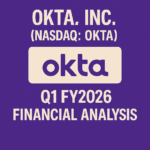Honda Motor Co., Ltd. (NYSE: HMC)
Q1 FY2026 Financial Analysis | August 6, 2025
Executive Summary
Honda Motor Co., Ltd. reported challenging Q1 FY2026 results, with sales revenue declining 1.2% to ¥5,340.2 billion, primarily due to decreased Financial Services revenue and negative foreign currency translation effects. Operating profit declined significantly by 49.6% to ¥244.1 billion, impacted by tariff effects and currency headwinds. Despite relatively stable revenue performance, profitability was severely pressured, with net income attributable to owners declining 50.2% to ¥196.6 billion. The Automobile business segment recorded an operating loss of ¥29.6 billion, highlighting sector-specific challenges.
Q1 FY2026 Highlights
Financial Performance
Honda’s Q1 FY2026 financial performance reflected significant challenges across key metrics. Sales revenue declined 1.2% year-over-year to ¥5,340.2 billion, primarily driven by decreased Financial Services business revenue and negative foreign currency translation effects. However, this modest revenue decline masked more severe underlying profitability pressures that impacted the company’s bottom line substantially.
Operating profit experienced a dramatic decline of 49.6% to ¥244.1 billion, significantly underperforming expectations. The primary drivers of this decline included tariff impacts affecting the company’s global operations and negative foreign currency effects that compressed margins across multiple business segments. These headwinds were only partially offset by increased profit attributable to higher sales volumes in certain segments.
Net income attributable to owners of the parent declined 50.2% to ¥196.6 billion, translating to earnings per share of ¥46.80 compared to ¥81.81 in the prior year period. This represented a 42.8% decline in per-share earnings, reflecting both lower absolute profits and a reduced share count due to the company’s share repurchase activities during the period.
The company’s balance sheet showed some pressure, with total assets declining 2.9% quarter-over-quarter to ¥29,874.5 billion. Cash and cash equivalents decreased 11.4% from March 31, 2025, to ¥4,013.7 billion, primarily due to share repurchases totaling ¥363.9 billion during the quarter and dividend payments. Despite these outflows, Honda maintained a strong liquidity position to support ongoing operations and strategic initiatives.
Finance income and costs contributed ¥43.9 billion to pre-tax profits, down from ¥73.3 billion in the prior year, reflecting lower interest income and other financial items. The effective tax rate remained relatively stable, with income tax expense of ¥77.4 billion on pre-tax profits of ¥292.3 billion, indicating a tax rate of approximately 26.5%.
Business Segment Performance
| Business Segment | Revenue (¥ billions) | YoY Change | Operating Profit (¥ billions) | Profit Change |
|---|---|---|---|---|
| Motorcycle Business | ¥951.6 | +1.5% | ¥189.0 | +6.4% |
| Automobile Business | ¥3,474.6 | +1.2% | (¥29.6) | Loss vs ¥222.8B profit |
| Financial Services | ¥831.6 | -11.3% | ¥85.0 | +0.04% |
| Power Products & Other | ¥82.5 | -12.7% | (¥0.2) | Improved from ¥0.8B loss |
Motorcycle Business demonstrated resilience amid challenging market conditions, with revenue increasing 1.5% to ¥951.6 billion and operating profit growing 6.4% to ¥189.0 billion. This strong performance reflected Honda’s continued market leadership in motorcycles globally, with particular strength in emerging markets where two-wheeled transportation remains essential.
Automobile Business faced significant headwinds despite revenue increasing 1.2% to ¥3,474.6 billion. The segment recorded an operating loss of ¥29.6 billion, a dramatic swing from the ¥222.8 billion profit in the prior year period. This deterioration was primarily attributed to tariff impacts, particularly affecting U.S. operations, and negative foreign currency translation effects that compressed margins on globally manufactured vehicles.
Financial Services Business experienced revenue pressure with an 11.3% decline to ¥831.6 billion, though operating profit remained relatively stable at ¥85.0 billion (up 0.04%). The revenue decline reflected reduced demand for automotive financing and leasing services, partly due to lower automobile sales volumes and changing customer financing preferences in key markets.
Power Products and Other Businesses continued to face challenges with revenue declining 12.7% to ¥82.5 billion. However, the operating loss narrowed slightly to ¥0.2 billion from ¥0.8 billion in the prior year, indicating some progress in cost management and operational efficiency improvements within this smaller segment.
The stark contrast between motorcycle and automobile performance highlighted Honda’s diversified business model benefits and risks. While the motorcycle division’s strength helped offset some automobile weakness, the automobile segment’s challenges significantly impacted overall profitability due to its larger revenue base and typical margin profile.
Balance Sheet & Cash Flow Analysis
Honda’s balance sheet remained relatively strong despite quarterly pressures, with total assets of ¥29,874.5 billion as of June 30, 2025, representing a 2.9% decrease from March 31, 2025. Key balance sheet movements included:
- Cash and Cash Equivalents: Decreased to ¥4,013.7 billion from ¥4,528.8 billion, primarily due to significant share repurchases and dividend payments
- Trade Receivables: Declined to ¥962.7 billion from ¥1,160.8 billion, reflecting improved collection efficiency and seasonal patterns
- Receivables from Financial Services: Increased to ¥8,948.9 billion from ¥8,928.6 billion, indicating continued customer financing activity
- Inventories: Decreased to ¥2,363.3 billion from ¥2,470.6 billion, showing improved inventory management
- Total Equity: Declined to ¥12,062.8 billion from ¥12,627.8 billion, primarily due to share buybacks
Cash flow performance showed mixed results across operating, investing, and financing activities:
Operating Cash Flow was positive at ¥85.7 billion, a significant improvement from negative ¥81.3 billion in the prior year period. This improvement was driven by better working capital management, including favorable changes in trade receivables (¥186.6 billion improvement) and inventories (¥77.8 billion improvement), partially offset by decreased trade payables.
Investing Cash Flow remained negative at ¥210.1 billion, reflecting continued capital investments in property, plant, and equipment (¥128.2 billion) and intangible assets (¥72.2 billion). The company also made strategic investments in equity-method investments totaling ¥44.8 billion, indicating ongoing expansion efforts despite current profitability challenges.
Financing Cash Flow was significantly negative at ¥325.1 billion, primarily driven by substantial share repurchases of ¥363.2 billion and dividend payments of ¥147.9 billion to shareholders. This reflected Honda’s commitment to returning capital to shareholders even during challenging operating conditions.
The company’s financing liabilities increased slightly to ¥11,554.5 billion from ¥11,451.3 billion, primarily related to the financial services business operations. Honda maintained its investment-grade credit profile with a diversified funding base supporting its global operations.
Fiscal Year 2026 Outlook
Honda provided updated guidance for fiscal year 2026 (ending March 31, 2026), reflecting continued cautious expectations amid ongoing global challenges:
- Sales revenue expected to decline 2.7% to ¥21,100 billion from ¥21,683 billion in FY2025
- Operating profit forecast at ¥700 billion, down 42.3% from ¥1,213 billion in FY2025
- Profit before income taxes expected to decline 46.1% to ¥710 billion from ¥1,318 billion
- Net income attributable to owners projected at ¥420 billion, down 49.8% from ¥837 billion
- Earnings per share forecast at ¥105.07 based on expected share count
The outlook reflects several ongoing challenges:
Automotive Industry Headwinds: The company expects continued pressure on the automobile business from tariff impacts, particularly affecting U.S.-China trade relationships, and ongoing supply chain disruptions. Electric vehicle transition costs are also expected to pressure margins as Honda invests heavily in electrification technology.
Currency Volatility: Honda anticipates continued foreign exchange headwinds, particularly with the Japanese yen’s movements against major currencies affecting translation of overseas earnings. The company’s significant global operations make it particularly sensitive to currency fluctuations.
Raw Material Costs: Elevated commodity prices, particularly for steel, aluminum, and rare earth materials essential for electric vehicle production, are expected to continue pressuring input costs throughout FY2026.
Despite these challenges, Honda management expressed confidence in several strategic initiatives that should support performance in the latter half of the fiscal year, including new model launches, continued expansion in electric vehicles, and operational efficiency improvements from ongoing restructuring efforts.
Strategic Initiatives & Transformation
Honda continues to execute on its long-term strategic transformation focused on electrification, autonomy, and operational excellence:
Electrification Strategy
- EV Investment: Continued significant capital allocation toward electric vehicle development and manufacturing infrastructure
- Battery Technology: Partnerships with leading battery manufacturers to secure next-generation battery technology and supply chain resilience
- Model Pipeline: Accelerated rollout of electric vehicle models across both automobile and motorcycle segments
- Charging Infrastructure: Strategic investments in charging network partnerships to support customer adoption
Operational Excellence
- Supply chain optimization initiatives to reduce costs and improve efficiency despite tariff challenges
- Manufacturing footprint rationalization to optimize global production capacity and reduce currency exposure
- Digital transformation initiatives across all business segments to improve customer experience and operational efficiency
- Cost structure improvements through automation and process optimization
Honda’s “2030 Vision” remains focused on achieving carbon neutrality for all products and corporate activities by 2050, with intermediate targets including:
- 100% electric vehicle sales in North America by 2040
- Global motorcycle electrification leadership by 2030
- Significant reduction in manufacturing emissions through renewable energy adoption
- Expansion of power products portfolio including hydrogen fuel cell technology
The company’s commitment to research and development remained strong, with R&D expenses increasing to ¥292.9 billion from ¥215.9 billion in the prior year, representing 5.5% of sales revenue. This investment level demonstrates Honda’s dedication to innovation despite current profitability pressures.
Risks & Opportunities
Opportunities
Risks
Conclusion
Strengths
- Motorcycle business resilience with 6.4% profit growth
- Strong balance sheet with ¥4.0 trillion in cash and equivalents
- Diversified global operations providing risk mitigation
- Continued investment in R&D and electrification strategy
- Improved operating cash flow generation
Areas of Concern
- Significant automobile business operating losses
- Sharp decline in overall profitability (50% decrease in net income)
- Tariff and currency headwinds impacting margins
- Challenging FY2026 outlook with continued profit pressure
- Increased capital requirements for EV transition
Summary
Honda’s Q1 FY2026 results highlighted the significant challenges facing the company in its transformation journey. While sales revenue declined modestly by 1.2% to ¥5,340.2 billion, operating profit plummeted 49.6% to ¥244.1 billion, reflecting the severe impact of tariffs, currency headwinds, and structural industry challenges.
The most concerning development was the automobile business swinging to an operating loss of ¥29.6 billion from a substantial profit in the prior year. This underscores the magnitude of challenges facing Honda’s largest revenue segment, including tariff impacts, currency translation effects, and competitive pressures in the global automotive market.
Despite these near-term challenges, Honda’s motorcycle business demonstrated resilience with both revenue and profit growth, while the company maintained its strong balance sheet and continued investing in long-term strategic initiatives. The ¥292.9 billion in R&D spending reflects Honda’s commitment to its electrification strategy and future competitiveness.
Looking ahead to FY2026, management’s cautious outlook projects continued pressure with operating profit expected to decline 42.3% for the full year. While these results present significant challenges, Honda’s diversified business model, strong financial position, and strategic focus on electrification and operational excellence position the company to navigate current headwinds and emerge stronger in the evolving mobility landscape.




